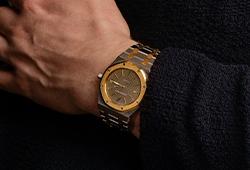Lena Cronqvist
'Den röda tråden'
Signed L. Cronqvist and dated 1983. Oil and tempera on canvas 152 x 100 cm.
Provenance
Galerie Belle, Västerås.
Galleri Kavaletten, Uppsala.
Private Collection, Sweden.
Exhibitions
Galerie Belle, Västerås, 'Målaren och hennes modell', exhibition no. 242, 1983.
Liljevalchs konsthall, Stockholm.
Literature
Nina Weibull, 'Reflections and Creativity - A Study of Lena Cronqvist's 'The Painter and her Model' ', a PhD Thesis, Konstvetenskapliga institututionen, Stockholms Universitet, 2006, illustrated in colour full-page pl. 5 and in b/w p. 75.
More information
From 1982 onwards, Lena Cronqvist often returned to the motif of the model, the artist and the mirror. This subject came to interest her deeply and she produced a total of 23 paintings that were exhibited at SAK's travelling exhibition in 1987. The suite begins with a self-portrait in which she sits at a table filled with paint, brushes in hand. The series ends with two works of her at her mother's deathbed, both titled 'August 1986'. Sune Nordgren has described the creation of the series "The painter and her model" as a mourning process in the time after her father's death, characterised by loss and the certainty of her mother's inexorable ageing:
"In different guises, as if trying out different roles, she holds a hand mirror close to her. But she does not always see her own face reflected. Sometimes she sees, as if under the surface of the mirror, the image of her aged mother, a reminder of all that is transient. Then Lena brings the mirror even closer to her, makes every effort to meet this hypnotic gaze, and with her free hand she grips a bundle of brushes tightly. To the work! The only way out is to paint, to work without reflection, for hours, to reach those brief moments when the image takes over and decides itself. Becomes true. So that she can search for herself among all these images, a whole and coherent figure of all the possible ones: the child, the woman, the mother, the artist. A whole gallery of Lena."
The mood is varied in the extensive suite of paintings, some images are dark, the face surfacing in the mirror becomes a demon to be subdued.
Shadowy images from the past appear on the wall behind the subject. The model's face is interchangeable, sometimes it is the artist's own, sometimes a mask or an unknown person. However, the recurring brushes that the model grips tightly symbolise hope and creation as a path to another reflection of existence.
In the current work, we encounter a brighter and more peaceful scene. The subject is bathed in light, which is enhanced by the whitewashed wall in the background. The artist portrays herself sitting serenely on a stool in the studio with her upper body exposed. The hands holding the mirror and brushes rest calmly in her lap. The painter's palette has been stored away on the wall behind her and seems to fade into the background. She has resolutely turned the hand-mirror away from her, lifted her chin and her gaze is set on the future. On the floor to her right lies a forgotten toy horse, a memory from a bygone era. Has the artist found her whole and coherent self?
Lena Cronqvist has spent an entire artistic life consistently and curiously exploring what it really means to be human. She has depicted people in their most vulnerable situations, from the defenseless infant to the elderly man on his deathbed. In between, she has sculpted with colour and painted children's play, adults' awkward attempts at tenderness and their longing for love, and using herself as a model, she has questioned the self and the role of the individual in relation to the collective. Lena Cronqvist has a unique ability to explode and merge boundaries between the inner space and the outer reality, the personal experience and the general historiography, the highly personal and the universal.
Artist
Lena Cronqvist is born and raised in Karlstad. Her interest for the arts came early in her life, and she spent the first year of her studies in England, near Bristol’s Art School. Upon her arrival back in Sweden, Cronqvist began a short-lived education at Konstfack, leaving to study painting at the Royal Academy of Fine Arts. When examining Lena Cronqvist's painting, it delves into "painting" in its more traditional sense. She is indeed a painter in the grand modern tradition, frequently turning to Edvard Munch and Francis Bacon’s art as inspirational sources. Yet she also had numerous art historical references and a deep love for the craft. Cronqvist excelled as a colourist, finding harmony in the most unusual colour combinations – few have managed to paint warmth and cold successfully at the same time. Her subject matter is often perceived as challenging and overly private by many. She often models herself for her art, posing in mundane situations imbued with a sharp psychological character. Her “Modonna-pictures” from the 1970s are a good example of this. She turns our gaze away from the conventional, notably in her portrayal and depiction of girls, which is fascinating. Cronqvist depicts these girls as ugly, simple, and altogether uncomfortable – a great contrast to how woman were normally portrayed in art. In more recent years, Lena Cronqvist has studied the effect of aging, using herself as a study. Moreover, Cronqvist is a very successful sculptor, and several of her works in bronze have been sold great sums in the auction world. She is also gifted in graphic productions, of which “Strindbergsmappen” is the most well-known. Among her most renowned works is "The Betrothal," a paraphrase of Jan van Eyck's symbol-laden painting "The Arnolfini Portrait." In Cronqvist's reinterpretation, artist and husband Göran Tunström are the main characters, with equally weighty symbolism but carrying entirely different meanings. Where van Eyck's painting features a loyal dog, Cronqvist replaces it with a cat—a symbol of independence.
Read more

























































